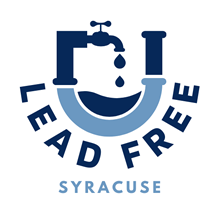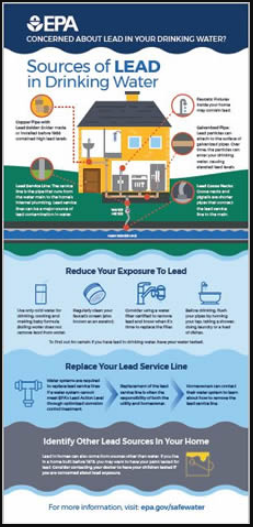Lead
Drinking Water Quality: Lead
What are the health effects of lead?
The EPA has determined that lead in drinking water is a health concern at certain levels of exposure. Lead is found throughout the environment in lead-based paint, air, soil, household dust, food, certain types of pottery porcelain and pewter, and water. Lead can pose a significant risk to your health if too much of it enters your body. Lead builds up in the body over many years and can cause damage to the brain, red blood cells and kidneys. The greatest risk is to young children and pregnant women. Amounts of lead that will not hurt adults can slow down normal mental and physical development of growing bodies. In addition, a child at play often comes into contact with sources of lead contamination – like dirt and dust – that rarely affect an adult. It is important to wash children’s hands and toys often, and to try to make sure they only put food in their mouths.
Lead in drinking water, although rarely the sole cause of lead poisoning, can significantly increase a person’s total lead exposure, particularly the exposure of children under the age of 6. EPA estimates that drinking water can make up 20% or more of a person’s total exposure to lead.
How does lead enter our water?
Lead is unusual among drinking water contaminants in that it seldom occurs naturally in water supplies like groundwater, rivers and lakes. Lead enters drinking water primarily as a result of the corrosion, or wearing away, of materials containing lead in the water distribution system and in building plumbing. These materials include lead-based solder used to join copper pipe, brass, and chrome-plated brass faucets.
In 1986, Congress banned the use of lead solder and flux containing greater than 0.2% lead, and restricted the lead content of faucets, pipes and other plumbing materials used in new installations or repairs to a maximum level of 8%, which was at the time considered “lead free.” However, the lead in the “lead free” plumbing materials meeting the 1986 requirements is still subject to corrosion. In 2014 the limit for new installations and repairs was lowered to 0.25%. Construction predating June 1986 may have plumbing components with lead levels up to 50%. When water stands in lead pipes or plumbing systems containing lead for several hours or more, the lead may dissolve into the drinking water. This means the first water drawn from the tap in the morning may contain fairly high levels of lead.

are partnering to provide water filters to
City of Syracuse households with pregnant women and children six and under routinely present. This initiative addresses concerns about the potential presence of lead in drinking water in some Syracuse homes due to lead service lines.
More Information
Drinking Water Quality: Lead in Schools
- Subpart 67-4 Lead Testing in School Drinking Water Regulations
- United States Environmental Protection Agency (EPA) – 3Ts for Reducing Lead in Drinking Water Toolkit
- EPA – 3Ts for Reducing Lead in Drinking Water in Schools (2018 Revised Manual) (PDF)
- 3Ts Manual Highlights
- The 3Ts Checklist
- NY State Department of Health (NYSDOH) – Lead Testing of School Drinking Water
NYSDOH Lead Resources:
- NYSDOH – Lead Testing in School Drinking Water 2020 Compliance Requirements Presentation (PDF)
- NYSDOH – QUICK REFERENCE GUIDE Recommendations for Sampling Lead in NYS School Drinking Water (PDF)
- NYSDOH – FREQUENTLY ASKED QUESTIONS For School Buildings and Grounds Personnel Lead in NYS School Drinking Water (PDF)
- NYSDOH – “Substantial Compliance” Waivers (PDF)

